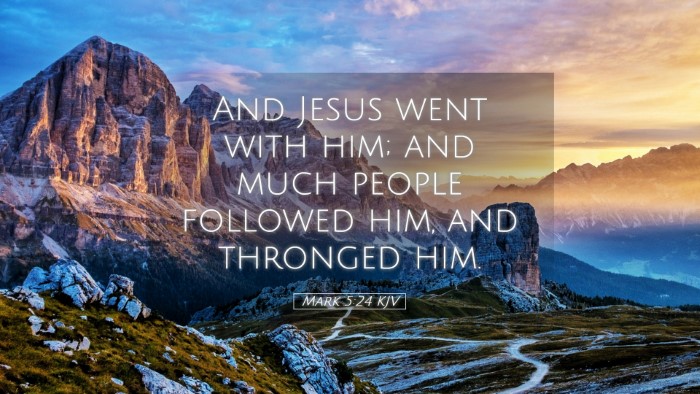Contextual Overview
Mark 5:24 is nestled within a narrative that highlights the power and compassion of Jesus amidst human desperation and need. This passage follows the account of a man named Jairus, a ruler of the synagogue, who pleads with Jesus to heal his dying daughter. The urgency of Jairus' plea captures the intensity of the moment, showcasing the intersection of faith, desperation, and the pressing crowd around Jesus.
Commentary Insights
1. The Companionship of Jesus
According to Matthew Henry, the phrase “Jesus went with him” reflects not only physical movement but also the willingness of Jesus to enter into the struggles of humanity. Jesus' readiness to accompany Jairus signifies His compassion and accessibility. This idea emphasizes that in times of desperation, Jesus does not remain distant but chooses to draw near, providing comfort and hope.
2. The Crowd’s Presence
Albert Barnes notes that the large crowd that followed Jesus illustrates various human conditions—curiosity, desperation, and faith. The crowd represents society’s differing responses to Christ. While some may be drawn by mere curiosity, others, like Jairus, demonstrate faith. The emphasis on the crowd heightens the sense of urgency in Jairus' situation, as it symbolizes the obstacles that can impede one’s access to Jesus.
3. The Nature of Faith
This passage invites consideration of faith. The act of Jairus seeking Jesus reflects a deep belief in the power and authority of Christ. Clarke emphasizes that Jairus' request is made publicly, highlighting his faith despite his high social standing, which could have led to public ridicule. This teaches that true faith often requires setting aside pride and societal expectations.
4. Human Need and Divine Intervention
As Henry articulates, this verse encapsulates the essence of human need met by divine intervention. The juxtaposition of Jairus’ urgent plea against the backdrop of a crowd emphasizes the chaotic nature of life. It is within such chaos that individuals often find themselves desperately seeking the touch of the Savior. The concept of “thronging” suggests a hindrance to access; thus, those in need must press through barriers to reach Jesus.
5. The Call to Action
Jairus' action in coming to Jesus reflects a proactive faith—a call to all who are desperate. This narrative provokes introspection for pastors and theologians about the importance of action in faith. Barnes encourages leaders to consider how they guide their congregations in seeking Christ amidst life's tumult. The challenge posed is whether we are leading individuals to actively pursue Jesus in their moments of distress.
6. Implications for Ministry
This passage serves as a poignant reminder for pastors and ministry leaders about the nature of their calling. As Clarke indicates, they are to be shepherds guiding their congregations to seek Christ. The throngs of people represent those in need of healing, hope, and restoration; ministers are called to facilitate access to Jesus, encouraging others to reach out in faith.
Conclusion
Mark 5:24 serves as a powerful verse that encapsulates themes of faith, compassion, and community. Through the lens of public domain commentaries, we see a rich tapestry woven from the threads of need, response, and the embodiment of divine love through Christ. For pastors, students, theologians, and scholars, this passage remains a profound invitation to examine the nature of their faith and their call to lead others toward the life-giving presence of Jesus.


